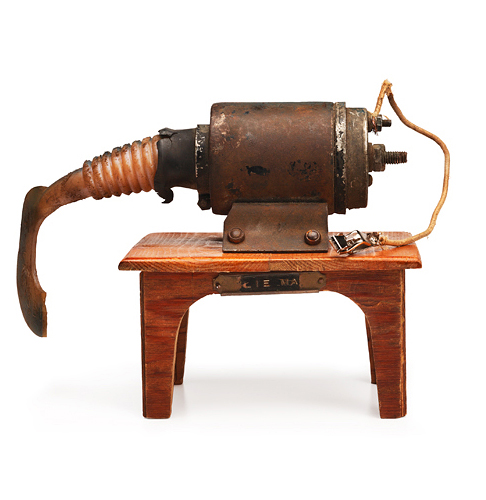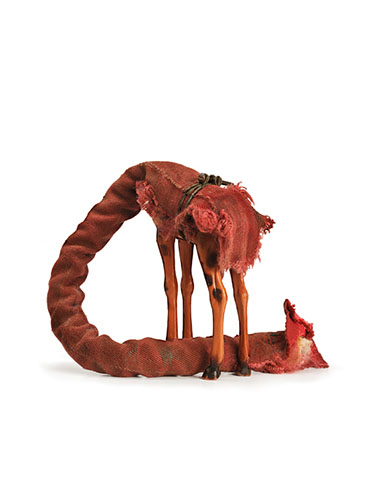.jpg) |
The striking, surreal large-format digital photographs of Berkeley’s Peter Honig employ the conventions of commercial photography — sharp focus, straightforward composition, shadow-less lighting and a white backdrops — to examine and subvert the consumer desires implanted by ads bombarding us from catalogues, newspapers, magazines, television and the internet.
Honig is a commercial photographer by day, with a background in fine-art photography and art history, so he knows how powerful images can be, even when multiplied ad infinitum and ad nauseam (despite Walter Benjamin’s erroneous theory about the loss of esthetic aura). The son and grandson of photographers, Honig brings to the setup table not only his workman-like skills (fifty product shots a day), but in addition, three separate but related strands of visual culture: the Dada collage tradition of Hannah Hoch, John Heartfield, and Max Ernst; snippets of reality from pre-existing printed matter, recontextualized to reflect the disjuncture of contemporary life; and the setup tradition of James Casebere, Laurie Simmons and others who manufacture sculptural subjects or tableaux in the manner of set designers and prop artists solely as subjects for photographs.
 |
Honig, with large-scale pictures, fills our mental “consumer advertising space, … [our] space of desire…. a delivery system or channel that people are conditioned to respond to” with enigmatic subjects, sometimes humorous and absurd, sometimes more serious. A fan of both the “warm” handmade tradition of California Beat and Funk assemblage art (Bruce Conner, William Wiley, Robert Hudson) and the deadpan, conceptual studies of contemporary industrial landscapes by the likes of Lewis Baltz, Robert Adams and Bernd and Hilla Becher, Honig searches out “everyday objects with potential for vocabulary,” and over the course of sometimes lengthy gestation periods, teases out the “resonances” that various conglomerations reveal.
Curiously, works that read too strongly as sculpture in real space read as mere documentation in photographs; so the assemblages have to play to the camera, so to speak, and work visually only in reproduction.
Printed at three by four feet and mounted on aluminum panels, the images resemble store display signage — but advertising what? In Dream of Flighta bird appears to have crashed onto small salmon-pink bed and decayed into a skeleton sporting a few feathers; the headboard and footboard are carved into wavy lines suggesting birds in flight, perhaps Van Gogh’s crows. In Follow-Up Visit, Neurologist’s Office, 74 Harley St., London,we see a stone wall with an arched, transomed doorway and gated porch, before which sits a small shapeless figure with a baglike torso and a disc-shaped head — Kafka’s tragically stoic Man from the Country, the eternal supplicant, crossed with one of George Grosz’s fussball-headed, featureless automatons.
Printed at three by four feet and mounted on aluminum panels, the images resemble store display signage — but advertising what? In Dream of Flighta bird appears to have crashed onto small salmon-pink bed and decayed into a skeleton sporting a few feathers; the headboard and footboard are carved into wavy lines suggesting birds in flight, perhaps Van Gogh’s crows. In Follow-Up Visit, Neurologist’s Office, 74 Harley St., London,we see a stone wall with an arched, transomed doorway and gated porch, before which sits a small shapeless figure with a baglike torso and a disc-shaped head — Kafka’s tragically stoic Man from the Country, the eternal supplicant, crossed with one of George Grosz’s fussball-headed, featureless automatons.
 |
In Revised Testing Station a cylindrical electric motor sits atop a small table, forming the torso and legs of a mechanical horse; a gooseneck plastic sleeve and dangling sock constitute its neck and bowed head. A similar metamorphosis takes place in Extension. In it, a giraffe’s neck, covered by a long red snakelike sleeve has ingested the animal’s head; it arches down and rests on the ground between the hooved feet. Pan Am Disaster refers, of course, to Flight 103, the jetliner that crashed in Lockerbie, Scotland, in 1988. Honig’s pile of smithereens becomes a toy-like symbol of human pride and frailty, a modern version of Caspar David Friedrich’s famous Romantic painting, The Wreck of Hope: dreams dashed to pieces.
It is unlikely that collectors will cease to see art as speculative investments and consumer goods; that revolution that would be economically undesirable anyway. Honig’s parody product shots, however, like Barbara Kruger’s subversive détournements of fashion photography, remind us that the art we admire, acquire and display really do say something about us, just as lifestyle ads do, only it’s not always as flattering as we think.
—DEWITT CHENG
Peter Honig at Mercury 20, Oakland, through Nov. 28, 2009
I have been an avid fan of Peter Honig’s prolific art for three decades. That written, I am pleased to see (and read) that he is being recognized an artist and not merely as an irritant. Kudos to him for developing new ideas that inspire others to write his praises more eloquently this.